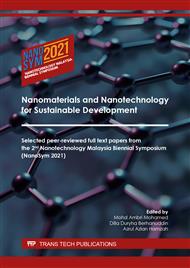[1]
N. Jaziri, A. Boughamoura, J. Müller, B. Mezghani, F. Tounsi, M. Ismail, A comprehensive review of Thermoelectric Generators: Technologies and common applications, Energy Rep. 6 (2020) 264-287.
DOI: 10.1016/j.egyr.2019.12.011
Google Scholar
[2]
T. M. Tritt, Measurement and characterization techniques for thermoelectric materials, Mat. Res. Soc. Symp. Proc. 478 (1997).
Google Scholar
[3]
P.J. Patil, A.M. Patil, Review on thermoelectric devices, Int. J. Emerg. Technol. Adv. Eng. 3 (2013) 681-688.
Google Scholar
[4]
J. Martin, Computational Seebeck coefficient measurement simulations, J. Res. Natl. Inst. Stand. Technol. 117 (2012) 168.
DOI: 10.6028/jres.117.009
Google Scholar
[5]
D. Champier, Thermoelectric generators: A review of applications, J. Energy Convers. Manag. 140 (2017) 167-181.
Google Scholar
[6]
T. Maekawa, K. Kurosaki, H. Muta, M. Uno, S. Yamanaka, Thermoelectric properties of perovskite type strontium ruthenium oxide, J. Alloys Compd. 387 (2005) 56-59.
DOI: 10.1016/j.jallcom.2004.06.053
Google Scholar
[7]
S. Hébert, D. Flahaut, C. Martin, S. Lemonnier, J. Naudem, C. Goupil, A. Maignan, J. Hejtmanek, Thermoelectric properties of perovskites: Sign change of the Seebeck coefficient and high temperature properties, Prog. Solid. State Ch. 35 (2007) 457-467.
DOI: 10.1016/j.progsolidstchem.2007.01.027
Google Scholar
[8]
M. A. Ramírez, E. E. Castillo, Thermoelectric simulation using COMSOL Multiphysics and analysis of contact resistances effects (2015).
Google Scholar
[9]
S. Krishna, M. Muralikrishna, R. Gowrishankar, Understanding Thermoelectric behavior of material using COMSOL, J. Appl. Phys. 9 (2017) 79-89.
Google Scholar
[10]
X. Wang, H. Wang, W. Su, J. Zhai, T. Wang, T. Chen, F. Mehmood, C. Wang, Optimization of the performance of the SnTe uni-leg thermoelectric module via metallized layers, J. Renew. Energy. 131 (2019) 606-616.
DOI: 10.1016/j.renene.2018.07.067
Google Scholar
[11]
H. He, Y. Wu, W. Liu, M. Rong, Z. Fang, X. Tang, Comprehensive modeling for geometric optimization of a thermoelectric generator module, J. Energy Convers. Manag. 183 (2019) 645-659.
DOI: 10.1016/j.enconman.2018.12.087
Google Scholar
[12]
T. Wu, P. Gao, Development of perovskite-type materials for thermoelectric application, J. Mater. 11(2018) 999.
Google Scholar
[13]
M.C. Robbins, Development of thermoelectric devices: design, fabrication and characterisation, Cardiff University. (2015).
Google Scholar
[14]
S. Telang, Optimization of MEMS based waste heat recovery thermoelectric generator by modification of design and material use, J. Power Energy Envir. & Intel. Cont. (2018) 126-131.
DOI: 10.1109/peeic.2018.8665649
Google Scholar
[15]
S. Ivanov, P. Nordblad, R. Mathieu, R. Tellgren, C. Ritter, Neutron diffraction studies and the magnetism of an ordered perovskite: Ba2CoTeO6, Dalton Trans. 39 (2010) 5490-5499.
DOI: 10.1039/b927498g
Google Scholar
[16]
S. Renge, Y. Barhaiya, S. Pant, S. Sharma, A review on generation of electricity using Peltier module, J. Eng. Res. Technol. 6 (2017) 453-457.
DOI: 10.17577/ijertv6is010308
Google Scholar
[17]
M. Jaegle, Simulating thermoelectric effects with finite element analysis using COMSOL,, Proc. ECT. 222 (2007).
Google Scholar
[18]
S. Yushanov, L. Gritter, J. Crompton, K. Koppenhoefer, Multiphysics analysis of thermoelectric phenomena, J. Model. Simul. (2011) 1-11.
Google Scholar
[19]
K. Teffah, Y. Zhang, X. L. Mou, Modeling and experimentation of new thermoelectric cooler–thermoelectric generator module, J. Energies. 11 (2018) 576.
DOI: 10.3390/en11030576
Google Scholar
[20]
D. Ebling, M. Jaegle, M. Bartel, A. Jacquot, H. Böttner, Multiphysics simulation of thermoelectric systems for comparison with experimental device performance, J. Electron. Mater. 38 (2009) 1456-1461.
DOI: 10.1007/s11664-009-0825-0
Google Scholar
[21]
H. Jouhara, Thermoelectric generator (TEG) technologies and applications, Int. J. Thermofluid. (2021) 100063.
Google Scholar
[22]
S. Kumar, A. Gupta, G. Yadav, H. P. Singh, Peltier module for refrigeration and heating using embedded system, Recent Dev. Control Autom. Power Eng. RDCAPE (2015) 314-319.
DOI: 10.1109/rdcape.2015.7281416
Google Scholar


